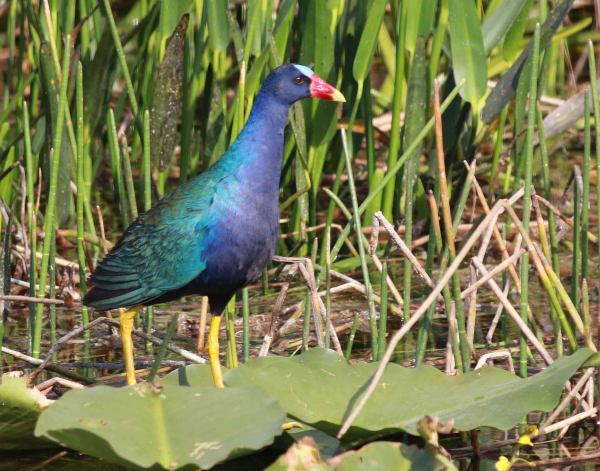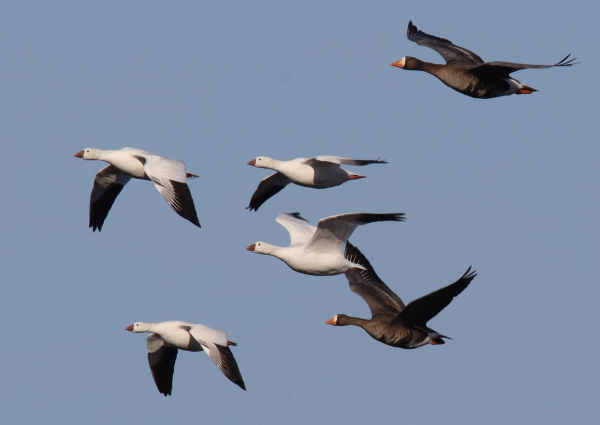
A colorful Purple Gallinule was observed and photographed by a birder at Loxahatchee National Wildlife Refuge in southeast Florida (photos by Paul Konrad).

Waterfowl such as these Ross’s Geese and White-fronted Geese have benefitted enormously from the islands of habitat created by America’s 573 national wildlife refuges.
|
For more than a century our national wildlife refuges have attracted birders looking to add a rare or iconic species to their life list, among millions of outdoor enthusiasts. The new national-level results from the National Wildlife Refuge System’s visitor survey shows that visitors to our nation’s national wildlife refuges had a 97 percent satisfaction rating in the quality of the overall experiences offered by national wildlife refuges across the United States. The survey monitored visitor experiences at refuges, with the results demonstrating the Service’s ability to meaningfully connect people with wildlife and the outdoors.
“National wildlife refuges protect iconic species and provide world-class outdoor recreational opportunities that connect the American public with nature,” said Cynthia Martinez, Chief of the National Wildlife Refuge System. With continued support and engagement from partners, we can uphold the legacy of conservation that defines the National Wildlife Refuge System. It truly is one of our nation’s best ideas.”
The National Wildlife Refuge System is an unparalleled network of 573 national wildlife refuges and 38 wetland management districts, including at least one national wildlife refuge in every state, and within an hour’s drive of most major metropolitan areas. More than 69 million Americans visit national wildlife refuges every year! National wildlife refuges provide vital habitat for thousands of species and access to world-class recreation opportunities including birding, photography, and environmental education among a variety of other wildlife and nature-based activities. In doing so, refuges support regional economies of $3.2 Billion per year and support more than 41,000 jobs.
The results demonstrate the relevance of national wildlife refuges to the public through high-quality visitor experiences. The results also show the US Fish & Wildlife Service’s commitment to maintaining access for priority uses and understanding changing demands for outdoor recreation experiences now and in the future. The survey found that visitors most often participated in birding (46 percent), and wildlife observation (59 percent), along with hiking and walking (56 percent) during the previous 12 months.
Refuge satisfaction is surveyed every 5 years to understand how visitor trends are changing over time. The National Visitor Survey was conducted at refuges with 50,000 or more annual visits, and the 2018-2023 survey period produced more than 20,000 survey responses from visitors at 141 Refuge System locations that account for approximately 70 percent of total visitation. In addition to national insights, results at the individual refuge level provide key information for local and regional decision making.
Overall, the National Visitor Survey results reflect the importance of national wildlife refuges for high-quality outdoor experiences. Continued monitoring of these activities will provide a foundation for ensuring access to these outdoor opportunities for future generations. To learn more about the survey, you can refer to The U.S. Fish and Wildlife Service Announces National Visitor Survey Results | U.S. Fish & Wildlife Service (fws.gov) (What state has the most national wildlife refuges? North Dakota!)